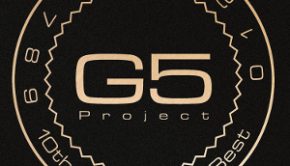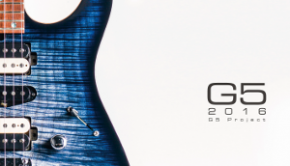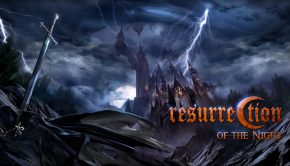Castlevania The Concert: Stockholm, February 2010

Funnily enough, I never grew with a NES. As a consequence, I pretty much missed the whole Castlevania series (with the exception of Super Castlevania IV and the Game Boy games) until the mid 2000s, and therefore, being also quite unfamiliar to its music; this changed when I started collecting VGM and discovered the many, many gems in all of their soundtracks, developing a love for most of the music as if I had played the games since the very start.
With that said, I can confidently assume I’m not the only one who was kind of startled at the fact that Castlevania music hadn’t been featured much on orchestral arrangements, especially considering it’s one of the most popular and still standing franchises from that era. There has been very few exceptions scattered through on other concerts, but these, were no more than “brief” medleys covering only a handful of themes, mainly the veteran ones. So, when news broke out about a concert completely dedicated to Castlevania, I couldn’t help but to get extremely excited about it (and once again, I’m sure I was not the only one). Better yet, Michiru Yamane would be attending as well as performing on the concert, which would feature a mix of rock and orchestra elements. Certainly, it sounded promising, and it didn’t fail to deliver.

The concert was held at the Stockholm Concerthall on the February 19, 2010 at 19:00 and performed by the Stockholm Youth Symphony Orchestra (SUSO for short). The gates were opened one hour before that, though, so that people could buy meet & greet tickets and program books, or just wait getting ready in the hall. Meanwhile, several speakers scattered around the place played usual clichéd horror-theme noises and screams, as well as teasing little cues of Vampire Killer and the like, getting everyone warmed up and really eager to get in.
Finally, we were allowed inside the main concert hall, decorated with some horror-like elements like candels, spider webs, and even some skeletons, and everything started rolling. We were first introduced with “Introduction” from Legacy of Darkness, a rather slow and very ambient track, which slowly built up to a really climactic small arrangement of “Bloody Tears”. That was when Dracula himself in his coffin (that’s David Westerlund, the man behind the project) was brought into the stage, and resurrected once again, to join in the next theme. With “Dracula’s Castle” from Symphony of the Night, the concert officially started, and in a good way; both the rock band and the orchestra were fully represented here, with an emphasis on the strings leading the main melody. A kind of straightforward arrangement for the most part, but with some interesting variations here and there, and an excellent track to start off and get an idea of what to expect.

After a little introductory speech from David, more Symphony of the Night followed, with “Moonlight Nocturne”. This one took a full orchestra approach and gained quite a much more varied sound, making the piece truly come to life. After that came another fan favourite, “Simon’s Theme” from Super Castlevania IV. The organ makes its first appearance here, played by Simon Belmont himself (that’s Erik Eklund, the producer). The theme was a close arrangement of the original, featuring a nice use of strings and the addition of the rock band, with a little competitive interplay between the organ and guitar towards the end. Then another Symphony of the Night suite came in, with a short but nice performance of Prayer by a soloist singer from the SUSO, followed by “Lost Painting”; the instrumentation here was really spot on, with some beautiful strings accompaniment at certain parts throughout. A very enjoyable arrangement.
Dracula then proceeded to tell us his thoughts on Eternal life, introducing us to the first guest artist of the night: Asuka Nakamura, who would play the piano on the next suite, this time from Super Castlevania IV again. It consisted of “Entrance Hall” followed by “Chandeliers”. Honestly, I was kind of surprised at the track selection on this one, because these two had never clicked me that much compared to other themes in the original game, which I thought could suit better. Surprisingly I was proved wrong, because these turned out to be some of best performances in the concert. I was stunned at how well both tracks worked with an orchestral arrangement, with some very good use of strings. It was flawlessly performed and had a really nice creative ending.

David showed up again and talked to us about how in the past, during the Final Fantasy on TourConcerts, he had been pondering the idea of a Castlevania Piano Collections project, pointing the way to the next songs. This is what the next suite was about; David would be playing piano solo arrangements of “New Messiah” and “Praying Hands” from Castlevania II: Belmont’s Revenge. The GB Castlevania soundtracks have always been of my favourites from the series, so I was extremely happy to see them featured here as well, as they are usually overlooked. “New Messiah” starts out at high speed, only to fool you and then take a really mellow and slow pace, building up again to a more frantic section with a synthesized chorus as accompaniment. “Praying Hands” followed a similar structure with a slow first half, then continued with a more upbeat second half. Personally, I think this was one of the standouts of the concert. Not only the arrangements were incredibly well done, but the performance was what made them shine so much. It was a touching segment.
David once again introduced us to the next suite, featuring two of the most popular tracks fromCastlevania Bloodlines: “The Sinking Old Sanctuary” and “Calling From Heaven”. “The Sinking Old Sanctuary” had actually a more subtle and mellow tone than the original, which was a bit different from what I expected, but the way it was arranged made it work out nicely nonetheless, specially with some beautiful use of strings. On “Calling From Heaven”, Maria Eklund (younger sister of Erik Eklund), who had already performed at the Final Fantasy on Tour Concerts, came back in to perform as lead violinist along the main violinist from the SUSO. Both succeeded to deliver a skillful performance with a frantic playing speed. The arrangement was once again very centered on strings, and while I found the pitch of the melody was maybe a bit high, it was still impressive.
Coming close to the end of Act 1, finally one of the most awaited moments of the night arrived, with David introducing Michiru Yamane herself, as the audience stood up and exploded in cheers and ovations. She would be playing the harpsichord along the orchestra on an already cult classic fromSymphony of the Night, “Wood Carving Partita”. The arrangement here was a nice and faithful one, without deviating too much from the original, aside from some added little segments to make an extended version. Not a bad thing, though, especially after being performed quite well.

As the end of Act 1 was right there, what a better way to end it than playing a classic Old-School Medley? After a little speech, David joined the orchestra and the rock band to perform on electric piano, as they started with “Vampire Killer”. It was a very nice and kind of medium paced arrangement, sort of mellow and medium with the piano having an 8bit-like sound taking the lead at first, to be followed by the guitar later on. Secondly, “Bloody Tears” came in, which had an arrangement based off the one on Rondo of Blood. The orchestra was more prominent here, although the guitar got its moment to shine on the second half. With a really nice and raw yet subtle transition, Beginning took over in full scale. The track was powerfully performed in a very grand and bombastic way, with both the guitar and flutes carrying the melody in the first and second half respectively. And with this, Act 1 came to and end.
After a short break, we were back in, and the concert promptly restarted with “Introduction” fromCastlevania 64. This was not too different an arrangement of the original, which would be a perfect tie-in for the next piece: “Opposing Bloodlines” from Rondo of Blood. I was really satisfied with the arrangement here, because even though the base was quite rock-oriented and could lead you to think it would be simpler, the full orchestra was used in a really effective way, emphasizing the epic tone the original already had. Awesome start for the second part.
Next up, David would invite Yamane once again into the stage to play the piano along the orchestra in the next piece: a full-length arrangement of “Waltz of the Pearls” from Symphony of the Night. One nifty tidbit about this track is that it was arranged by Yamane herself exclusively for this concert. On the first half it’s basically the same as the original, with the added complexity of the orchestra; but, later on, it starts to deviate a little bit, adding some nice piano parts. A really nice contribution from Yamane.

Coming up was another suite, this time much more rock-oriented. It started out with a more recent theme, “Clocktower” from Aria of Sorrow; Asuka Nakamura returned to play the acoustic piano. The orchestra really made the track gain a very powerful sound here and it had a very suitable arrangement despite the simpler feel of the original. The only complaint I had was that sometimes at the middle, the piano went quite offsynch for a while; I doubt this was intentional, but at least it didn’t last too long. Anyway, as the theme was ending, a drum solo would pick up and continue on to the next track — another classic, “Wicked Child” from Castlevania. Here, the orchestra took an almost non-existant role, as the focus shifted entirely to the rock band and the electric piano playing the main melody. Later up on the second half, the guitar came ahead and performed an impressive guitar solo, with the electric 8bit piano coming after with a shorter solo to finish off, introducing small cues from “Dr. Wily Castle 1” from Mega Man 2 and the “Main Theme” from Chrono Trigger, much to the surprise of the attendees; they even threw in the “Chocobo Theme” at the very end. What a way to catch the audience off guard. Those were some of the most fun moments of the concert, with people bursting in applause.
Following after that, there was even more Game Boy goodness. David once again took the lead, and played another piano solo suite (this time on the grand piano) of “Ripeseeds” and “Psycho Warrior”, both from Castlevania II: Belmont’s Revenge. These two had slightly more liberal arrangements (maybe a bit too liberal, at parts, where it was bordering on just improvisation). However, the performance was really good — as much as the first piano suite — and just as enjoyable. I personally enjoyed “Psycho Warrior”; it had a very menacing tone at first, with eerie bass, only to slow down all of a sudden later, and take a softer and somewhat sadder approach. As I already suggested to David after the concert, I think they should do more works like these, as they really stand out.

With the previous tracks being based primarily on piano, it was the turn of the Organ. David talked us a little bit of trivia about the Concert Hall’s organ, and then gave way to the next suite, starting with “Requiem for the Gods” from Symphony of the Night. It was well adapted to the orchestra, and even some singers from the SUSO stepped out to perform along (albeit they sung a bit low). Once over, Simon Belmont took over fully with the organ, as he started playing an Organ Medley, starting with the “Chromatische Phantasie” from J.S. Bach featured on Castlevania II: Belmont’s Revenge. I always thought this track must be quite hellish to perform because of its wide note range and very frantic pace, yet Erik succeeded to perform it almost flawlessly, with a very powerful sound. The second track in the medley was “Passepied” from Claude Debussy, also featured on that game. From the frantic and grand approach of the previous track, it switched to a much more low and bubbly sound, which actually fitted the piece really well, and then built up again for the next track: “Clockwork” from Castlevania III. Everything I said about “Cromtasiche Phantasie” applied to this one as well, with its really fast tempo. I must admit that, even though I love the originals for the impressive job recreating an organ on their respective hardware, one cannot help to not to be mesmerized when listening to them on such a grand scale. Anyway, while “Clockwork “was the same as the original for the most part, it had some cool little variations, like sometime in the second half, where it would switch to a similar sound setup to that of “Passepied”, only to get back on full all of a sudden. A pretty fun segment.
As the end to the concert was getting close, we got to another fan favourite: “The Tragic Prince” fromSymphony of the Night. This was mostly the same song but arranged to benefit more from the full orchestra which made it gain a tad bit of depth. One minor thing I noticed here, though, is that for some reason the guitar didn’t sound that right (at least compared to the original). I think it is not related to performance but to the actual sound of it. Then again the original track had a really good guitar track, so I might be nitpicking. It still was quite enjoyable and succeeded in getting you pumped up for the last sprint until the end.

Sadly, it was time to wrap things, and so, coming up was the last suite. By now you must be thinking “where’s Illusionary Dance??”. If you have to finish off a concert better to do it right: Dracula started to mock us, humans, for being mere weaklings, when Simon Belmont broke in, and both recreated the infamous dialogue from Symphony of the Night. And then… yes, “Illusionary Dance”. It was a straightforward arrangement, but still, it came out as really powerful and extremely climactic thanks to the full orchestra adaptation. It was quite amusing as well, because, as the track played, Dracula wandered around the stage killing off members of the band, to then finally try to suck the director’s blood. However, night doesn’t last forever and his time was over with “Dracula’s Death” from Super Castlevania IV, and Death and his assistant brought his coffin back into stage for Dracula to rest. As the powers of Darkness were being vanished away from the hall, “Ending Theme”, also from Super Castlevania IV, came in. As with Chandeliers previously on the first Act, I was surprised to see how well this theme worked with the orchestra, with spot on adaptation of the strings and organ. It served as a very soft and emotive finale.
But it wasn’t over yet. Shortly after, David came back to the stage, and called out many of the members of the project as well, explaining a bit of their roles and how it was working on the project. After the obligatory round of applauses and cheerings, they got prepared as people expected for a mandatory encore. With a big surprise, Yamane was back once again, to play the harpsichord on “Wandering Ghosts” from Symphony of the Night. The arrangement was similar, but an extended version of the original, introducing quite a few orchestra elements while retaining nicely the loungy and latin feel of the original. I only wish they mastered the overall sound a bit better here. The harpsichord was a tad bit low, being eclipsed by the rest of the orchestra and the rock band for quite a while. It was still nice and well performed, though. But no, that wasn’t it, still; there was even another encore. Just as in Act 1, it’s better to finish off the big way. So, yes, the last track was “Beginning”, just as they had played it on the first act. I can’t comment much more, aside from stating that every concert should finish like this: encompassing, powerful, and climactic.

Once the concert ended and everyone started to move out, those of us who had patiently waited outside before the concert for the tickets were directed to the main lobby to wait while the artists were on their way. After a few minutes filled with nervousness, they finally arrived: David, Erik, Yamane, Director Glenn Mossop, and arrangers Patrik Jarlestam and Ossian Tove, along with a few others that I can’t remember for the life of me. They were there to meet the fans and sign program books and CDs. There, I had the chance to have a few words with some of them, who were quite nice to talk to, and I thanked them for such a fun night despite the great distance I had to travel (and considering some other game music enthusiasts I met, I wasn’t the only one). As the Concert Hall closed the gates, it was time to get back to the hostel, since, sadly, this “cursed” night had already ended.
Castlevania The Concert was something that surprisingly had never been done before. With a franchise of this popularity, I imagine expectations were pretty high. Sure, there were some minor flaws, particularly few mastering issues and little performance flaws here and there; I also think some more music from more recent games like Portrait of Ruin or Order of Ecclesia would have fit well, with Yamane attending (something in the form of a medley). But, honestly, despite all that I think I can safely assume that not many people would end up disappointed. It featured an impressive and broad track selection — I loved how the GB games weren’t overlooked — with a really good distribution that flowed smoothly. In addition, the variety of styles (piano solos, orchestra, rock band, organ…), largely good performances, and top-notch guests appearances made this concert a one truly unique experience that I can only hope will be repeated sometime in the future. I must once again thank all the team behind the project to have made this possible, and wish them even more success on upcoming projects.
Do you agree with the review and score? Let us know in the comments below!
4.5
Posted on February 19, 2010 by Kevin Sánchez. Last modified on March 1, 2014.














